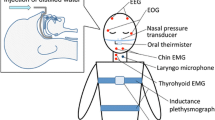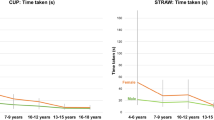Abstract
Sequential swallowing is the act of swallowing multiple times, without pausing. Because sequential swallowing requires breath-holding, it seems likely that it could increase the drive to breathe. This study was designed to determine if sequential swallowing is accompanied by an increased drive to breathe in young, healthy adults. We predicted that sequential swallowing would be accompanied by prolonged breath-holding in most cases, and that this would be followed by a recovery phase during which ventilation would increase for a brief period. Results showed that not only did healthy participants increase ventilation after sequential swallowing, they also experienced breathing discomfort (dyspnea) despite the fact that they usually continued to breathe during the swallowing sequence. Given that these effects are observable in young, healthy adults, it seems reasonable to assume that individuals with respiratory and/or neurological compromise would also have an increased drive to breathe during sequential swallowing.



Similar content being viewed by others
Notes
We found that drinking from a cup (without a straw) required neck extension, which created movement artifacts in the respiratory magnetometer data. That is, even minimal neck extension increased the magnitude of the rib cage signal, creating an apparent inspiration during breath-holding. Had we used a cup-drinking protocol rather than a straw-drinking protocol, our measurements of end-inspiratory lung volume might have been artificially inflated.
Nasal pressure was also recorded (using a nasal cannula connected to a pressure transducer); however, submental muscle activity was found to be a better indicator of the swallow, so the nasal pressure signal was not used for analysis.
References
Martin BJW, Logemann JA, Shaker R, Dodds WJ. Coordination between respiration and swallowing: respiratory phase relationships and temporal integration. J Appl Physiol. 1994;76(2):714–23.
Martin-Harris B, Brodsky MB, Price CC, Michel Y, Walters B. Temporal coordination of pharyngeal and laryngeal dynamics with breathing during swallowing: single liquid swallows. J Appl Physiol. 2003;94:1735–43.
Shaker R, Li Q, Ren J, Townsend WF, Dodds WJ, Martin BJ, Kern MK, Rynders A. Coordination of deglutition and phases of respiration: effect of aging, tachypnea, bolus volume, and chronic obstructive pulmonary disease. Am J Physiol. 1992;263(5 Pt 1):G750–5.
Perlman AL, Ettema SL, Barkmeier J. Respiratory and acoustic signals associated with bolus passage during swallowing. Dysphagia. 2000;15:89–94.
Dozier TS, Brodsky MB, Michel Y, Walters BC, Martin-Harris B. Coordination of swallowing and respiration in normal sequential cup swallows. Laryngoscope. 2006;116:1489–93.
Chi-Fishman G, Stone M, McCall GN. Lingual action in normal sequential swallowing. J Speech Lang Hear Res. 1998;41:771–85.
Daniels SK, Foundas AL. Swallowing physiology of sequential straw drinking. Dysphagia. 2001;16(3):176–82.
Global Initiative for Chronic Obstructive Lung Disease. Global strategy for the diagnosis, management, and prevention of chronic obstructive pulmonary disease. 2009. http://goldcopd.com. Accessed October 13, 2010.
Hixon TJ, Goldman MD, Mead J. Kinematics of the chest wall during speech production: volume displacements of the rib cage, abdomen, and lung. J Speech Hear Res. 1973;16:78–115.
Somers VK, Mark AL, Zavala DC, Abboud FM. Contrasting effects of hypoxia and hypercapnia on ventilation and sympathetic activity in humans. J Appl Physiol. 1989;67(5):2101–6.
Feldman JL, McCrimmon DR. Neural control of breathing. In: Squire LR, editor. Fundamental neuroscience. San Diego: Academic Press; 2008. p. 855–72.
Manning HL, Schwartzstein RM. Pathophysiology of dyspnea. N Engl J Med. 1995;333(23):1547–53.
Demediuk BH, Manning H, Lilly J, Fencl V, Weinberger SE, Weiss JW, Schwartzstein RM. Dissociation between dyspnea and respiratory effort. Am Rev Respir Dis. 1992;146(5 Pt 1):1222–5.
Banzett RB. Dynamic response characteristics of CO2-induced air hunger. Respir Physiol. 1996;105:47–55.
Wheeler Hegland KM, Huber JE, Pitts T, Sapienza CM. Lung volume during swallowing: single bolus swallows in healthy young adults. J Speech Lang Hear Res. 2009;52:178–87.
Wheeler Hegland K, Huber JE, Pitts T, Davenport PW, Sapienza CM. Lung volume measured during sequential swallowing in healthy young adults. J Speech Lang Hear Res. 2011;54:777–86.
Zenker W. Questions regarding the function of the external laryngeal muscles. In: Brewer D, editor. Research potentials in voice physiology. New York: State University of New York; 1964. p. 20–40.
Hixon TJ, Weismer G, Hoit JD. Preclinical speech science: anatomy, physiology, acoustics, and perception. San Diego: Plural Publishing; 2008.
Gross RD, Atwood CW, Ross SB, Olszewski JW, Eichhorn KA. The coordination of breathing and swallowing in chronic obstructive pulmonary disease. Am J Respir Crit Care Med. 2009;179:559–65.
Marks B, Mitchell DG, Simelaro JP. Breath-holding in healthy and pulmonary-compromised populations: effects of hyperventilation and oxygen inspiration. J Magn Reson Imaging. 1997;7(3):595–7.
Hoit JD, Lansing RW, Dean K, Yarkosky M, Lederle A. Nature and evaluation of dyspnea in speaking and swallowing. Semin Speech Lang. 2011;32:5–20.
Daniels SK, Corey DM, Hadskey LD, Legendre C, Priestly DH, Rosenbek JC, Foundas AL. Mechanism of sequential swallowing during straw drinking in healthy young and older adults. J Speech Lang Hear Res. 2004;47:33–45.
Acknowledgments
We acknowledge Robert W. Lansing, Ph.D., for his assistance with this study and his expertise in the area of dyspnea measurement, and Kelsie Grant, B.S., for her assistance with data analysis.
Author information
Authors and Affiliations
Corresponding author
Rights and permissions
About this article
Cite this article
Lederle, A., Hoit, J.D. & Barkmeier-Kraemer, J. Effects of Sequential Swallowing on Drive to Breathe in Young, Healthy Adults. Dysphagia 27, 221–227 (2012). https://doi.org/10.1007/s00455-011-9357-x
Received:
Accepted:
Published:
Issue Date:
DOI: https://doi.org/10.1007/s00455-011-9357-x




